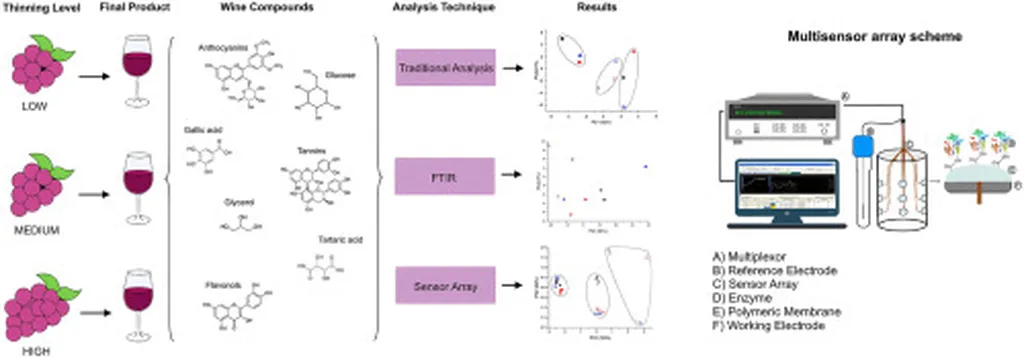In the heart of Italy, researchers are unlocking new ways to optimize wine quality, and their findings could send ripples through the global viticulture industry. A recent study published in the *Journal of Agriculture and Food Research* has demonstrated how advanced electrochemical biosensors could revolutionize the way winemakers approach cluster thinning, a critical process in vineyard management.
Cluster thinning, the practice of removing excess grape clusters to improve the quality of the remaining fruit, has long been a balancing act. Too much thinning can reduce yield, while too little can compromise wine quality. Stefano Pettinelli, a researcher at the University of Pisa, and his team have developed a novel biosensor array that promises to take the guesswork out of this delicate process.
The team subjected Tempranillo vines to three levels of cluster thinning—High (HY), Medium (MY), and Low (LY) yields—over three vintages. Using a bioelectronic tongue equipped with enzyme-functionalized potentiometric sensors and gold nanoparticles, they selectively detected key markers of wine quality, such as phenolic compounds and sugars. The results were striking.
“Our biosensor system effectively differentiated wines according to yield level, showing greater sensitivity and specificity than conventional techniques like FTIR spectroscopy,” Pettinelli explains. The study found that MY and LY wines exhibited greater phenolic and sugar content than HY wines, indicating better quality.
The implications for the agriculture sector are profound. Traditional methods of analyzing wine quality are often time-consuming and require specialized equipment. This biosensor technology, however, is portable and could be integrated into decision-support tools for real-time applications in wineries and viticulture operations.
The study also employed multivariate data analysis techniques, such as Principal Component Analysis (PCA) and Support Vector Machine Regression (SVM), to confirm strong correlations between biosensor responses and chemical parameters. These techniques not only validated the biosensor’s efficacy but also highlighted the potential of advanced analytical tools in precision agriculture.
Pettinelli and his team are optimistic about the future of this technology. “The integration of multivariate data analysis with advanced biosensors supports precision agriculture practices to optimize grape yield and wine quality,” he says. The biosensor system is currently at a pre-commercial development stage, but its potential to streamline viticulture practices and enhance wine quality is undeniable.
As the agriculture sector continues to embrace technological innovations, this research from the University of Pisa could pave the way for more efficient and precise viticulture practices. By providing winemakers with real-time, accurate data, this biosensor technology could help them make informed decisions that optimize both yield and quality, ultimately benefiting the entire industry.
In a field where tradition meets innovation, this study offers a glimpse into the future of wine quality assessment. As researchers continue to refine this technology, the viticulture industry may soon have a powerful new tool at its disposal, one that could redefine the standards of wine quality and production.

